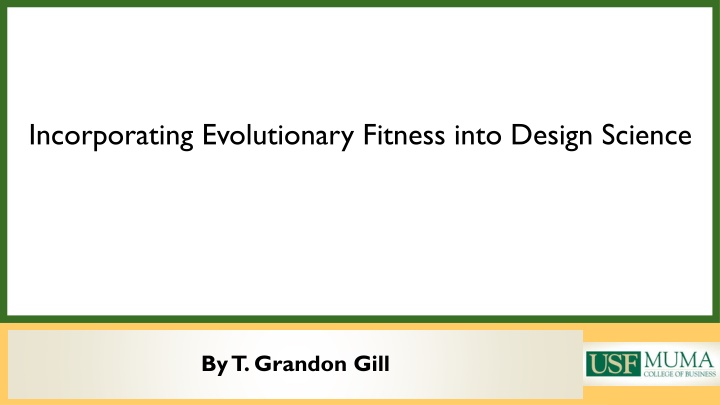
Evolutionary Fitness in Design Science: Enhancing Creativity and Outcomes
Explore the integration of evolutionary fitness principles into design science, focusing on enhancing creativity, refining outcomes, and understanding the real-world impact of design artifacts. Dive into the concepts of fitness in design, the application of evolutionary principles, and how they shape the success of designs across different contexts.
Download Presentation

Please find below an Image/Link to download the presentation.
The content on the website is provided AS IS for your information and personal use only. It may not be sold, licensed, or shared on other websites without obtaining consent from the author. If you encounter any issues during the download, it is possible that the publisher has removed the file from their server.
You are allowed to download the files provided on this website for personal or commercial use, subject to the condition that they are used lawfully. All files are the property of their respective owners.
The content on the website is provided AS IS for your information and personal use only. It may not be sold, licensed, or shared on other websites without obtaining consent from the author.
E N D
Presentation Transcript
Incorporating Evolutionary Fitness into Design Science By T. Grandon Gill
The design task and design science The concept of fitness Refocusing design outcomes Conclusions Overview
What is design science and why should we care about it? The Design Task and Design Science
Principal focus of design science end point is design artifact Real world determines ultimate success of the design artifact Representation & Symbols Guides design through feelings and creativity context driven External Environment Intuition and Experience Three Worlds of Design
Presents constraints Intelligence Determine design constraints Formalized Processes Creativity Design Develop design candidates Designer s Mind Real World Design Science Select design artifact Choice Estimates of Fitness Utility Artifact outcomes Fitness landscape Design Cycle and Role of Design Science
Applying the concept of evolutionary fitness to design Fitness
The success of a design can be characterized as its fitness Two possible interpretations, inspired by biology: Fitness Definition #1. The fitness of an organism describes its ability to survive at a high level of capacity over time. Fitness Definition #2. The fitness of an organism describes its ability to reproduce completely or in part and evolve over successive generations. Concepts are related, but can sometimes work against each other Example: population dynamics Nature of Fitness
Fitness #1: Looks at entire design (A) with respect to a specific context (i) FitnessAi = f(DesignAi,Contexti) Fitness #2: Looks at design in whole or in parts across all possible contexts. Along the lines of FitnessA = ??? ??? ?(DesignAi,Contexti) Where: pi is probability of Contexti occurring over time frame being considered SAi is fractional subset of DesignA that is used in Contexti i sums across all contexts in which DesignA may be applied in its entirety or in part Interpretation in Design Context
As components of a design interact, landscape becomes rugged. Example: ingredients in a recipe Rugged landscape characteristics Many local peaks Sharp drop-offs General rules fail to apply Landscape dynamics tend towards punctuated equilibrium, making prediction less reliable Implications Estimates of fitness (e.g., result of science ) and intuition become weaker Status quo becomes increasingly attractive Imitation often yields better results than analysis Design science becomes irrelevant ? Fitness and Complexity
Emphasizing reproduction over fit to a specific context Refocusing Design Outcomes
Fitness Decomposable Malleable Open Embedded in Design System Too Useful? Useful Novel Interesting Usefulness Elegant Usefulness vs. Fitness
Decomposable Promotes Modification (Mutation, Recombination) Malleable Open Promotes Quality, Consistency, Motivation Embedded in Design System Promotes Diversity Novel Promotes Diffusion Interesting Promotes Longevity Elegant Effects of Fitness Characteristics
Why should we care about design fitness? Conclusions
In an increasingly complex environment, predicting usefulness based on an initial design becomes increasingly difficult Example: increasing acceptance of agile methodologies Offers insights not necessarily self-evident (or, at least, justifications for insights) Can be applied in a practical manner Takes a longer-term view of design More suitable as a research focus given publication cycles Offers many research opportunities Validating proposed design characteristics Cross-fertilization with other biologically-inspired research areas, such as genetic algorithms Benefits of Fitness Approach


